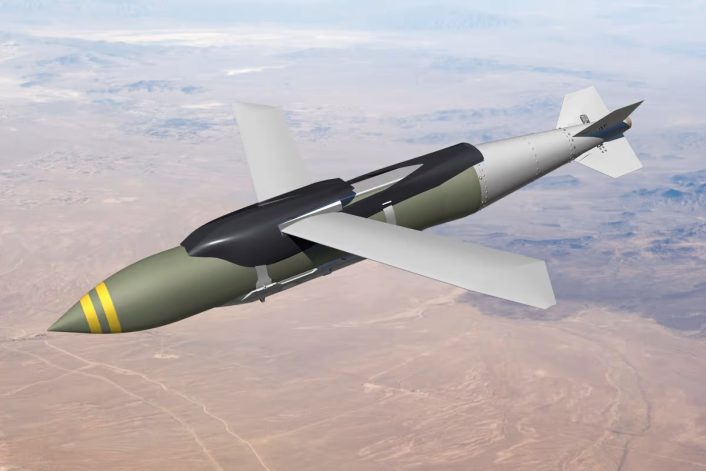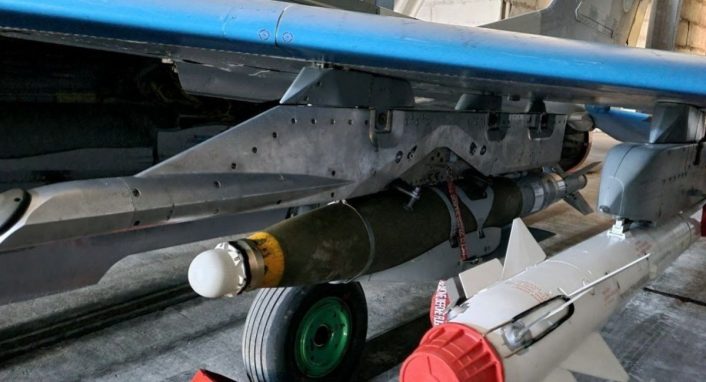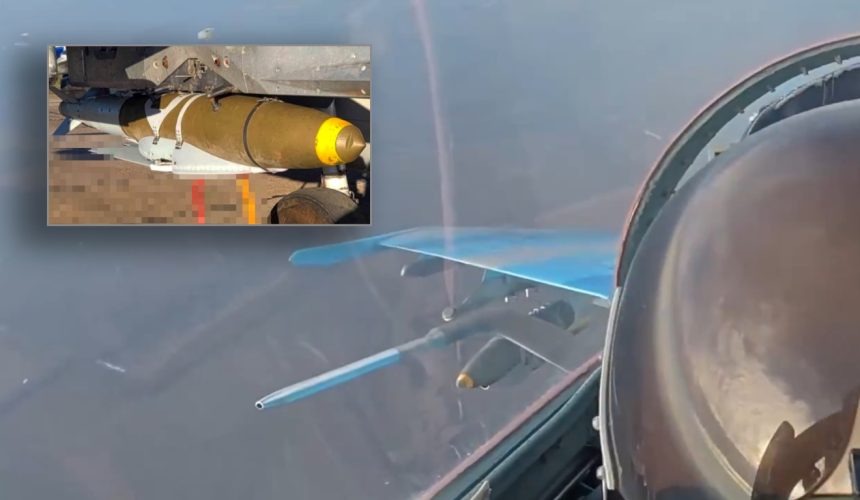Ukraine employed since 2023 the 500 lb JDAM-ER, whose existence was well documented, while the new 1,000 lb bomb might have been specifically produced for the Ukrainian Air Force.
Two years after the 500 lb GBU-62 JDAM Extended Range (ER) guided bomb was first reported among the weapons being delivered to Ukraine, it now appears the country has received a new 1,000 lb variant of the weapon, whose existence was previously unknown. In fact, a recently released video shows a Ukrainian Su-27 Flanker dropping two 1,000 lb JDAM-ER bombs against Russian targets.
The GBU-62, which has been used by both the Su-27 Flanker and MiG-29 Fulcrum, is based on the 500 lb (227 kg) Mk-82 bomb, while the new weapon, whose designation is unknown but could likely be GBU-63, is based on the larger 1,000 lb (454 kg) Mk-83 bomb. So far, the only known JDAM-ER variants were the GBU-62 and the 2,000 lb (907 kg) Mk-84-based GBU-64.
The Ukrainian Air Force just released what appears to be the first footage of a Ukrainian Su-27 Flanker dropping 1000lb JDAM-ER glide bombs on a Russian position.
The Mk83-based JDAMs in this video carry roughly double the explosive mass of previously seen JDAMs. pic.twitter.com/Z64pIWxoPc
— OSINTtechnical (@Osinttechnical) January 31, 2025
Neither Boeing or the U.S. military have mentioned the existence of a 1,000 lb JDAM-ER variant, with the latter using the JDAM-ER kit for the Mk-62 and Mk-64 Quickstrike mines of the U.S. Navy, a family of shallow-water, aircraft-laid mines used against surface and subsurface craft. While the 1,000 lb Mk-63 Quickstrike mine exists, the military has never mentioned it being modified with JDAM or JDAM-ER kits.
The JDAM Extended Range
The standard JDAM kit consists of a tail section that contains a Global Positioning System/Inertial Navigation System (GPS/INS) and body strakes for additional stability and lift. The JDAM Extended Range (JDAM ER) further adds a low-cost wing set to extend the JDAM’s standoff range to greater than 40 miles.
 A rendering of the JDAM-ER kit applied to a 2,000 lb bomb. (Image credit: Boeing)
A rendering of the JDAM-ER kit applied to a 2,000 lb bomb. (Image credit: Boeing)The development of the kit benefited from the GBU-39 Small Diameter Bomb (SDB), according to Boeing’s officials. “The JDAM ER wing kit takes advantage of the conventional JDAM aircraft interface and Small Diameter Bomb glide technology,” said in 2015 Beth Kluba, then vice president of Boeing Weapons and Missile Systems.
The JDAM-ER originates in the 2006/2008 time frame, when Boeing and the Australian DSTO (Defence Science and Technology Organisation) jointly developed and tested a wing-kit for the 500 lb GBU-38/B JDAM. The resulting glide bomb triples the range of JDAM, with some sources stating it can reach up to 50 miles when launched from high altitude. The GBU-62 JDAM-ER entered service with the Royal Australian Air Force in 2016.
In 2009, a similar effort was launched by Boeing and the South Korean company Times Aerospace Korea (TAK) developed a JDAM-ER wing-kit for the 2000 lb GBU-31/B JDAM. The development was expected to last 40 months, but the fielding date of the weapon has not been disclosed.
The only confirmed U.S. military application of JDAM-ER is part of the Quickstrike mines, specifically the Quickstrike ER. The designations GBU-62(V)1/B and GBU-64(V)1/B, in fact, refer to 500 lb MK 62 and 2000 lb MK 64 mines equipped with a JDAM-ER kit, respectively.
 A GBU-62 JDAM-ER under the wing of a Ukrainian MiG-29. (Image via X)
A GBU-62 JDAM-ER under the wing of a Ukrainian MiG-29. (Image via X)The GBU-62 JDAM-ER in Ukraine
Ukraine first received in 2023 the GBU-62 JDAM-ER (Joint Direct Attack Munition-Extended Range) guided bomb, which are being employed by its fighter jets thanks to special purpose-built pylons. This was first disclosed by U.S. Air Force Gen. James Hecker, head of U.S. Air Forces in Europe (USAFE), U.S. Air Forces Africa (AFAFRICA) and NATO’s Allied Air Command and, which provided details about Ukraine’s use of the JDAM-ER in March 2023.
“Recently, we’ve just gotten some precision munitions [to Ukraine] that had some extended range and go a little bit further than the gravity drop bomb and has precision [guidance],” Hecker said. “That’s a recent capability that we were able to give them probably in the last three weeks.” Gen. Hecker also referred to them specifically using the designation GBU-62.
As already mentioned, the kit combines a pop-out wing kit with the well-known GPS tail guide kit, improving the stand-off capabilities of the weapon, keeping the launching aircraft further away from enemy air defenses. It wasn’t immediately known which variant of the weapon was sent to Ukraine, especially since GBU-62 was the designation of the Quickstrike mine, however photos later showed that bomb body being employed with the JDAM-ER kit is the 500 lb Mk-82.
In March 2023, Ukrainian officials also confirmed the combat employment of the weapon, but the weapon was never visually confirmed in Ukrainian use until July 2023. A year later, the first video of its combat employment as seen from the cockpit of the MiG-29 emerged online.
The video showed the Fulcrum performing a standoff lofting attack, climbing at high altitude over friendly territory to further increase the range of the JDAM-ER, inverting the route shortly after releasing the weapon. The moment of the bomb release was shown clearly with a close-up view of its reflection in the cockpit mirrors.
The close-up view from the mirrors also allowed to get a better view of the pylons used to carry the JDAM-ER. In fact, the GBU-62 has been installed on the inner pylons of the aircraft by using a modified pylon with addition of the standard MAU-12 ejector rack (normally used on the F-15 and F-16), as well as what appears to be a GPS antenna in the front to possibly align the JDAM’s guidance kit before release.
As we recently reported, Ukraine is also expected to receive Home-on GPS Jam seekers to be integrated into existing JDAM wing kits. The seekers will help counter the proliferation of Russian electronic warfare systems that caused the effectiveness of GPS-guided weapons to take a plunge.
In November 2024, Australian Defence Magazine revealed that Australia also supplied JDAM-ERs to Ukraine. In fact, on Oct. 30, 2024, the Australian Defense’s Guided Weapons and Explosive Ordnance Plan revealed that Australia withdrew its 500lb JDAM-ER munitions from service in 2021 alongside the retirement of the legacy F/A-18A/B Hornet fleet.
The publication was able to confirm that at least some of those weapons were later transferred to Ukraine. The report also mentioned that the first JDAM-ER weapons were directly supplied by the U.S., while Australia confirmed that it had supplied Ukraine with unspecified air-to-ground munitions in April 2024.









